All woodworking enterprises make a profit from the sale of manufactured products. And the deeper the wood processing, the more profitable the production. Before buying equipment, each entrepreneur asks questions: What are the drying chambers for wood, what devices are equipped with, and which one to choose for your production?
If you choose the wrong equipment, then the profitability, on the contrary, will fall. And the greater range of wood drying kilns on the market makes the selection task even more difficult.
The main types of drying chambers are:
- Dielectric.
- Convector
- vacuum
- Aerodynamic
The method of drying wood in various ways was invented back in the 60s, but due to the high costs of electricity and the complexity of the design, technologies have only recently begun to be used. Most often all over the world use convector-type dryers. Why is this happening? Other designs can be used with a number of restrictions and subtleties of use. The main disadvantages of using inductive, condensing and vacuum wood dryers are:
- Aerodynamic chambers require more electricity;
- Condensation structures are expensive, and drying in them lasts 2 times longer than in convector ones.
- Vacuum dryers are expensive and also expensive to maintain.
- Dielectric ones require high energy costs, although they are considered one of the best.
Convector dryers
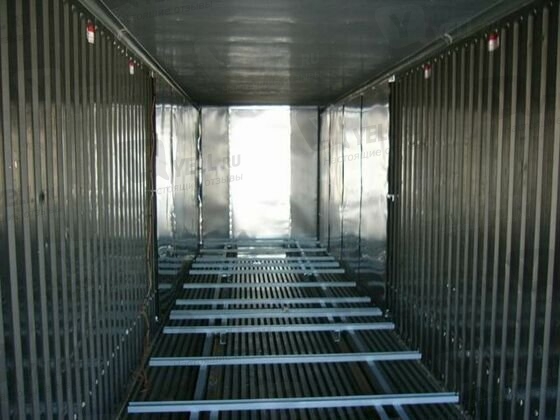 Convectors are used for drying wood of various species and sizes. Due to the simplicity of the design, convector chambers are inexpensive to maintain, which indicates reliability. Therefore, in order to increase profitability, in 90 cases out of a hundred they are purchased.
Convectors are used for drying wood of various species and sizes. Due to the simplicity of the design, convector chambers are inexpensive to maintain, which indicates reliability. Therefore, in order to increase profitability, in 90 cases out of a hundred they are purchased.
Working principle of convector dryer
Heating occurs from a gaseous carrier (drying agent). When heated, the raw material is tapped. The drying agent can be steam, flue gas, air. The moisture released from the wood serves as an additional moistening of the agent, the excess is drawn into the atmosphere with the help of ventilation.
The exchange of air in a convector dryer is not higher than 2% of the total, so the energy efficiency is noticeable.
Complete set and equipment of the convector dryer
There are many configurations from various manufacturers, but there are basic options:
- Equipment for an already built or under construction hangar of a drying structure.
- Fully design with hardware.
Equipment case
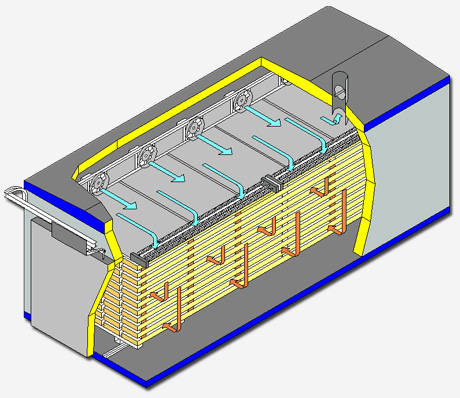 The body is completely made of metal, assembled on a monolithic-pillar foundation. The metal used for manufacturing is carbon steel or aluminum with an anti-corrosion coating. Outside and inside the hangar is lined with aluminum sheets. Separate elements inside the structure (deflectors, false flows, amplifiers, etc.) are also made of aluminum. The chamber is insulated with mineral wool in the form of plates.
The body is completely made of metal, assembled on a monolithic-pillar foundation. The metal used for manufacturing is carbon steel or aluminum with an anti-corrosion coating. Outside and inside the hangar is lined with aluminum sheets. Separate elements inside the structure (deflectors, false flows, amplifiers, etc.) are also made of aluminum. The chamber is insulated with mineral wool in the form of plates.
The structure is assembled in compliance with GOSTs and SNiPa. Options requiring additions and extensions are made according to an additionally developed scheme. The basic assembly is designed for an average snow load.
Convection chamber models
Convection drying chambers are produced by domestic and foreign companies. The most common are Helios: ASKM-7, ASKM-10, ASKM-15, ASKM-25. They are used for drying any type of wood of drying categories I, II, III and 0. According to reviews, these models work quickly, since German fans are used in the mechanism. And installation and maintenance of ASKM models is simple. The price is from 700,000 rubles, depending on the size and power.
Vacuum drying chambers
 Designs are designed specifically for expensive raw materials (teak, wenge, rosewood, oak, anger, etc.). Vacuum dryers can also be used for any softwood or hardwood.
Designs are designed specifically for expensive raw materials (teak, wenge, rosewood, oak, anger, etc.). Vacuum dryers can also be used for any softwood or hardwood.
Working principle of vacuum dryer
The vacuum dryer works from convector heating of wood and vacuum removal of excess moisture. The temperature regime is maximum +65 0C. But because of the vacuum, 0.09 MPa boils at 45.5 0C. This allows the drying process to be carried out without the aggressive effects of high temperatures, which does not create high internal stress, and the tree does not crack.
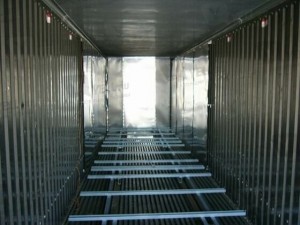 In the process of operation, the temperature rises by 65 0С, the automation is activated and the electric boiler is turned off. The upper part of the wood begins to cool, and moisture from the inside begins to flow to the drier parts. For the entire drying process, such processes can occur up to 250 times. So the moisture is evenly drawn out along the entire length and depth of the raw material. The maximum moisture difference in different parts of the tree can be 0.5-1.5%, and completely dried has a moisture content of 4-6%.
In the process of operation, the temperature rises by 65 0С, the automation is activated and the electric boiler is turned off. The upper part of the wood begins to cool, and moisture from the inside begins to flow to the drier parts. For the entire drying process, such processes can occur up to 250 times. So the moisture is evenly drawn out along the entire length and depth of the raw material. The maximum moisture difference in different parts of the tree can be 0.5-1.5%, and completely dried has a moisture content of 4-6%.
Models of popular vacuum designs
The most common model of vacuum chambers is Helios. Drying chambers for Helios wood differ in power, loading volume and other technical characteristics. More about TX Helios in the table:
| Technical parameters, Helios Vacuum (GV) | GV-4 | GV-6 | GV-9 | GV-12 | GV-16 |
| Possible volume of loaded raw materials, no more, m 3 | 4 | 6 | 9 | 12 | 16 |
| Parameters of the working mechanism (length, width, height), cm: LSHV | 430/192/192 | 630/192/192 | 650/230/230 | 850/230/230 | 1230/230/230 |
| The maximum possible heating temperature, degrees. With | up to 65 | up to 65 | up to 65 | up to 65 | up to 65 |
| Discharge kg/cm2 | — 0,92 | — 0,92 | — 0,92 | — 0,92 | — 0,92 |
| Drying time of various types and sections of wood to a moisture content of 4-5%, days: | |||||
| Oak, section 5.2 cm, damp. fifty% | 19 — 25 | 19 — 25 | 19 — 25 | 19 — 25 | 19 — 25 |
| Oak, section 5.2 cm, humidity 30% | 11 — 13 | 11 — 13 | 11 — 13 | 11 — 13 | 11 — 13 |
| Oak, Section 2.5 cm, humidity 50% | 10-11 | 10-11 | 10-11 | 10-11 | 10-11 |
| Oak, section 2.5 cm, humidity 30% | 8-9 | 8-9 | 8-9 | 8-9 | 8-9 |
| Coniferous, section 5.5 cm, humidity 50% | 7-8 | 7-8 | 7-8 | 7-8 | 7-8 |
| Coniferous, section 5.5 cm, humidity 30% | 6-5 | 6-5 | 6-5 | 6-5 | 6-5 |
| Required mains voltage, V | 380 | 380 | 380 | 380 | 380 |
| Connected power, kW | 15 | 18 | 30 | 36 | 72 |
| Average used power, kW | 8 | 10 | 17 | 20 | 35 |
| Helios drying chamber size (length, width, height), m: LSHV | 6,12,22,4 | 8,12,22,4 | 8,32,352,4 | 10,323,524,0 | 13,323,524,0 |
| Weight, t | 4 | 6,5 | 7,7 | 9,5 | 17,5 |
Aerodynamic chambers for wood drying
 These drying chambers are reminiscent of a metal box finished with a professional aluminum deck. An aerodynamic chamber of various modifications is used for drying all types of wood, with a load of 3-25 m3. On request, you can purchase chambers of individual design with a load of up to 43 m3.
These drying chambers are reminiscent of a metal box finished with a professional aluminum deck. An aerodynamic chamber of various modifications is used for drying all types of wood, with a load of 3-25 m3. On request, you can purchase chambers of individual design with a load of up to 43 m3.
The aerodynamic chamber is good because the work is fully automated and a minimum number of workers is needed.
The frame of the aerodynamic chamber consists of a solid metal sewn onto a supporting frame. The chamber is made in the form of a quadrangular box, into which it is convenient to load wood by car or by rail. ways. The entire internal structure is equipped with automatic condensate collectors.
Principle of operation
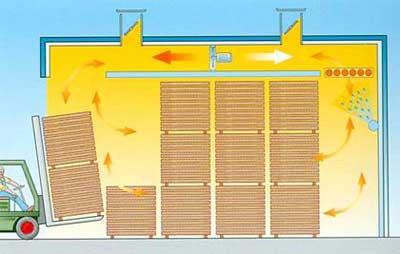 Drying is carried out under the influence of aerodynamic energy. Heated air circulates in the chamber under the influence of a specially designed aerodynamic fan. The air in the chamber, due to compression, increases the temperature on the centrifugal fan, specifically on its blades. Thus, aerodynamic losses are converted into thermal energy.
Drying is carried out under the influence of aerodynamic energy. Heated air circulates in the chamber under the influence of a specially designed aerodynamic fan. The air in the chamber, due to compression, increases the temperature on the centrifugal fan, specifically on its blades. Thus, aerodynamic losses are converted into thermal energy.
Heat is forced into the chamber, depending on the design, in reverse or dead-end. The work of the aerodynamic chamber is started by one button “start” and opens only after the cycle is completed.
Models of aerodynamic dryers
The most common dryers of the aerodynamic type Gelos SKV-25F, SKV-50F, SKV-12TA, SKV-25TA, SKV-50TA, as well as Italian EPL 65.57.41, EPL 65.72.41, EPL 65.87.41, EPL 125.72.41, EPL 125.87.41. Developed by Helios, specifically for drying coniferous material. They cost from 1,500,000 rubles.
Dryers with microwave chamber
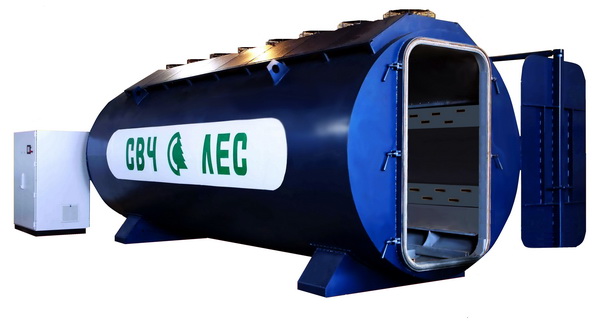 Microwave cameras have been invented quite recently. Such a dryer resembles a closed metal container. Operates under the influence of the reflective surface of microwave waves. Reminds me of how a microwave oven works. Using a microwave chamber, you can dry the material of any section and size. Microwave chambers have a simple design and you can adjust the wavelength to any length. This made it possible to dry any raw material using a microwave chamber. The attenuation mode of the microwave wave allows you to adjust the temperature inside the chamber. And reversible fans remove excess moisture from the system. Microwave drying is compared with dielectric drying, which is considered the most efficient, but is not used in Russia due to high electricity costs.
Microwave cameras have been invented quite recently. Such a dryer resembles a closed metal container. Operates under the influence of the reflective surface of microwave waves. Reminds me of how a microwave oven works. Using a microwave chamber, you can dry the material of any section and size. Microwave chambers have a simple design and you can adjust the wavelength to any length. This made it possible to dry any raw material using a microwave chamber. The attenuation mode of the microwave wave allows you to adjust the temperature inside the chamber. And reversible fans remove excess moisture from the system. Microwave drying is compared with dielectric drying, which is considered the most efficient, but is not used in Russia due to high electricity costs.
The main disadvantages of microwave chambers include wood moisture control and the high price of microwave dryers and electricity costs.
Models of microwave dryers
In Russia, this drying technology is offered by the engineering company in Moscow "Investstroy" - "SVCh-Les". Such an installation costs from 1,300,000 rubles. It is necessary to service the microwave forest once every half a year, at a price of 100,000 rubles.
Only half of the future profit depends on which camera the buyer chooses. Building and insulating a box is only part of all the work. It is important that the component equipment is of high quality.
Equipment for drying chambers
Equipment for dryers can be divided into types:
- Thermal system.
- Exhaust and humidification system.
- Rail structure for loading and unloading
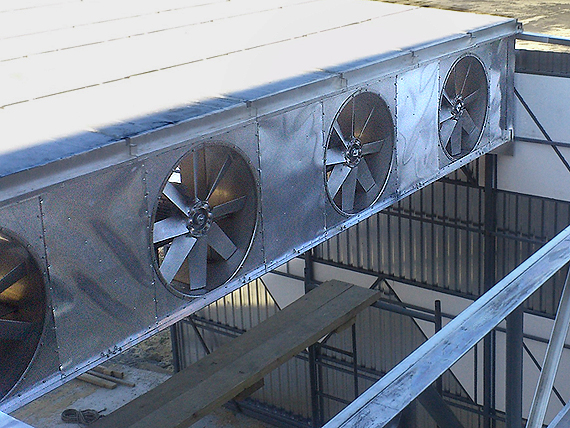 Ventilation equipment performs the role of uniform distribution of heated air. Installing a low-quality fan entails uneven drying of raw materials. According to GOST, the air movement inside the chamber should be optimally about 3 m / s. This can be achieved using high-quality and powerful fans. All fans have a rotary or axial connection system.
Ventilation equipment performs the role of uniform distribution of heated air. Installing a low-quality fan entails uneven drying of raw materials. According to GOST, the air movement inside the chamber should be optimally about 3 m / s. This can be achieved using high-quality and powerful fans. All fans have a rotary or axial connection system.
This equipment depends on the capacity and model of the drying chamber. The heat generator can be an electric heater or a heat exchanger. They are installed only by specialists, and they are used to pump and transfer thermal energy to wood. A system, such as a mini-boiler house for liquid, gaseous or solid fuel, can also act as a heat generator. It is convenient when work is carried out on waste wood production.
 The electra heater has a design consisting of a pipe and a chrome spiral wound around it. This generator has a small advantage: a simplified process for controlling the temperature inside the chamber.
The electra heater has a design consisting of a pipe and a chrome spiral wound around it. This generator has a small advantage: a simplified process for controlling the temperature inside the chamber.
Humidification system
To ensure constant uniform air humidity in dryers, humidification and exhaust equipment is used. Humidification is carried out by a complex system of nozzles, pipelines, and a solenoid valve.
The hood is carried out using a fan (usually rotary). The equipment works according to the following technology: when the humidity drops, the fan automatically turns off and the hood does not function. At the same time, the humidification of the air takes place by offsetting the evaporation of the liquid, which enters the nozzle automatically when the valve is opened.
When the humidity rises, on the contrary, the valve closes and the fan turns on.
Rail loading and unloading system
This equipment is installed at the stage of camera assembly. The system is made of rails, which are installed thoroughly. On top of them, stacked carts are attached, which are needed for storing wood. Raw materials are laid on them, and placed in a chamber, after drying, the carts are rolled out into the street and packaged.
When choosing a chamber for drying wood, it is better to use the services of professionals, but do not neglect the information of specialists on the network.